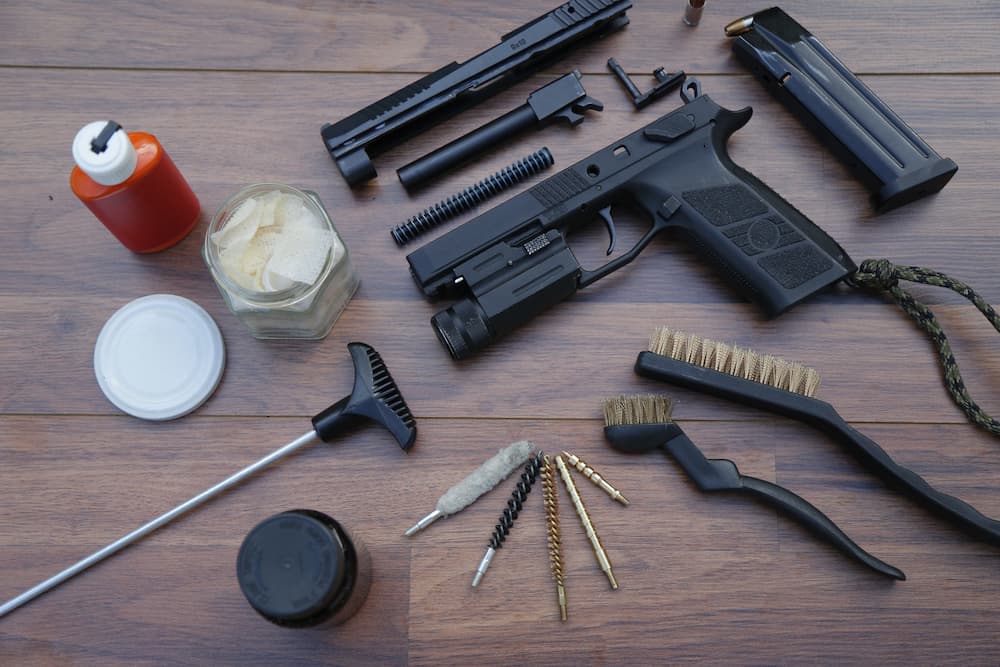Maintaining your Glock pistol
Proper maintenance is critical for keeping your Glock pistol safely functioning and reliable over years of service. In this article, we will provide an overview of the key steps you need to take to clean, lubricate, and care for your Glock.
Importance of maintenance
Like any mechanical device, pistols require routine maintenance to operate properly. Failure to adequately care for your Glock can result in dangerous malfunctions, reduced accuracy, and shortened service life. Staying on top of cleaning and lubrication ensures flawless functioning when you need it most.
Overview of process
Caring for your Glock involves field stripping to disassemble key components, scrubbing away fouling, careful lubrication, reassembly, and function checks. We’ll walk through each step to make the process fast and straightforward. Now let’s get started!
Getting started
Before diving into dismantling your Glock, follow these preliminary guidelines:
Read the manual
Every Glock comes with an owner’s manual covering recommended disassembly, cleaning, lubrication, and reassembly. Reading this ensures you follow safe and proper procedures.
Follow safety rules
Always adhere to your department’s firearm safety protocols. Make sure to clear your pistol, separate it from ammunition, and take protective measures before starting.
Use protective equipment
Wear safety goggles, disposable gloves, and ensure adequate ventilation in your workspace. Clean up any residue afterwards and wash your hands to minimize exposure.
How to clean your Glock
With safety gear on and a field stripped pistol, here is the detailed cleaning regimen:
Supplies needed
You’ll need solvent, brushes, patches/rags, compressed air, plastic picks, a cleaning rod, oil, and optionally a brass brush. Avoid letting excess solvent collect inside the pistol.
Field strip the pistol
Refer to your manual for proper disassembly. At minimum, separate the slide, barrel, recoil spring, and frame.
Clean the barrel
Solvent and brushing
Soak patches in solvent and run them through the barrel several times. Scrub the feed ramp, chamber, and interior with a brush. Let the barrel soak in solvent.
Oil and patching
Run dry patches through until clean. Use a bore brush with solvent, then wet patches with oil to capture debris. Finish by running dry patches until clean and inspected.
Clean the slide
Wipe down and scrub
Wipe down interior and scrub with a solvent-wet brush, avoiding the striker channel. Scrub rails and breech face. Detail clean behind extractor. Let slide soak muzzle down.
Detail clean breech face and rails
Clean breech face smooth. Use picks and patches to detail clean rails. Ensure sights and extractor area are cleaned.
Clean the frame
Wipe down exterior
Wipe down frame exterior and interior of mag well. Clean rails, trigger bar, ejector, and connector area. Refer to manual for part IDs.
Scrub with brush
Scrub nooks and crannies with brush and patches/rags. Blow out solvent with compressed air. Goal is a clean, dry frame.
Clean other components
Recoil spring
Wipe down recoil spring assembly with rag until clean and dry.
Magazines
Clean mag follower, feed lips, exterior with rag and brush. Periodically disassemble mags for deep cleaning.
Reassemble slide and frame
Once all components are cleaned to satisfaction, it’s time to lubricate and reassemble your Glock.
Lubricating your Glock
Apply oil sparingly – a little goes a long way. Excess oil attracts contaminants.
Applying oil
Barrel
Oil barrel exterior near muzzle and hood area contacting slide. Insert barrel and smear oil on locking lug.
Frame rails
Small drop of oil on each frame rail. Smear around top, sides and bottom.
Connector
Oil where trigger bar cam meets connector.
Reassemble and rack
Reinstall slide and rack multiple times to distribute oil.
Wipe down exterior
Clean excess exterior oil with a rag. Avoid leaving excess oil behind.
Function check
With basic reassembly complete, verify function:
Striker and trigger
Cock striker, hold trigger to rear, confirm reset.
Magazine locking
Insert unloaded magazine. Rack slide and lock back. Check mag removal and replacement cycles slide properly.
Final safety check
Clear pistol, remove magazine, visually inspect chamber before securing equipment.
Load up
With function checks complete, you’re ready to load:
Prepare magazines
Fill magazines with duty ammunition.
Load pistol
Load pistol and holster. Insert loaded magazines into mag pouches.
Secure equipment
Secure pistol and magazines. Resist urge for any last minute adjustments or checks.
Conclusion
Summary
That covers the essential process of dismantling, cleaning, lubricating, and verifying your Glock pistol. Follow these steps routinely to keep your pistol in flawless functioning order. Let us know if you have any other Glock maintenance questions!
Final thoughts
While routine, caring properly for your duty pistol takes diligence and care. Enlist help from your department’s armorer if anything seems beyond your experience level. Proper maintenance directly equates to safe and reliable carrying of your Glock in the field. Stay safe out there!
FAQs
What cleaning supplies do I need?
You’ll want solvent, lubricating oil, brushes, patches/rags, compressed air, plastic picks, a cleaning rod, and optionally a brass brush. Avoid excessive buildup of solvents inside your pistol.
How often should I clean my Glock?
Most experts recommend cleaning your Glock after every 500 rounds fired. Clean promptly after exposure to rain, dirt or other contaminants. How often between cleanings depends on amount of firing and operating conditions.
Do I need to clean my magazines?
While you don’t need to disassemble your magazines every time, you should wipe down the feed lips, follower, and exterior each cleaning to remove built-up crud. Periodically deep clean magazine internals as well.
How do I know if cleaning is needed?
Signs your Glock needs cleaning include feeding failures, difficulty racking the slide, visible fouling deposits, sluggish trigger reset, or accuracy degradation. Use your judgment – when in doubt, clean it out!
What areas most need lubrication?
Just a small drop of oil on frame rails, barrel exterior, connector, and locking lug is sufficient. Other areas just need cleaning without extra lubrication. Avoid over-oiling anywhere.






